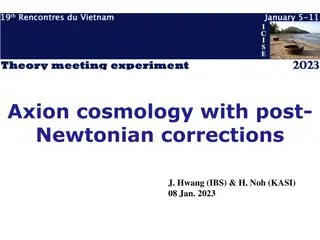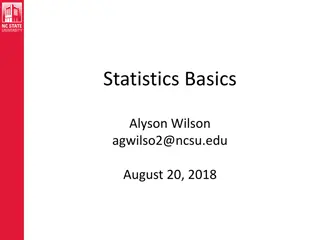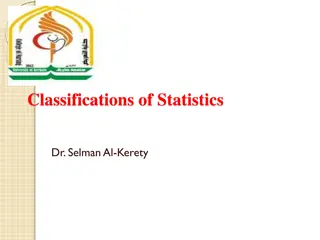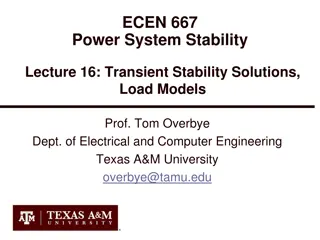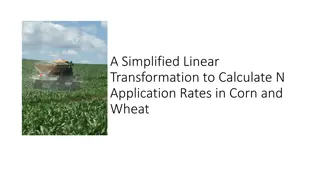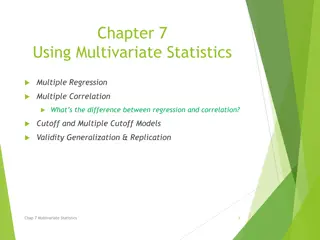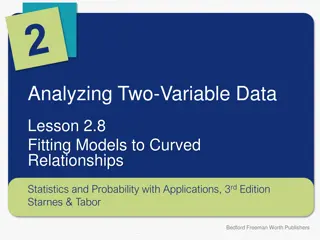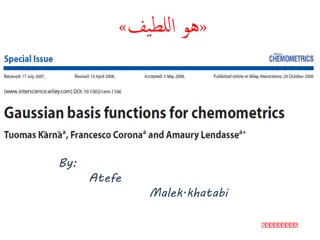Understanding Nonlinear Models in Statistics
Nonlinear models in statistics focus on exploring nonlinear relationships between quantitative variables. This involves defining exponential growth and decay, analyzing population data trends like the dramatic turnaround of bald eagles after the ban on DDT, and determining when linear models may not be suitable. The process of statistical investigation begins with a research question, followed by data collection, exploration, and drawing conclusions based on data analysis.
Download Presentation

Please find below an Image/Link to download the presentation.
The content on the website is provided AS IS for your information and personal use only. It may not be sold, licensed, or shared on other websites without obtaining consent from the author. Download presentation by click this link. If you encounter any issues during the download, it is possible that the publisher has removed the file from their server.
E N D
Presentation Transcript
Nonlinear Models Concepts in Statistics
Nonlinear Models We begin a statistical investigation with a research question. The investigation proceeds with the following steps: Produce Data: Determine what to measure, then collect the data. Explore the Data: Analyze and summarize the data. Draw a Conclusion: Use the data, probability and statistical inference to draw a conclusion about the population. In Nonlinear Models, we focus on nonlinear relationships between two quantitative variables.
Exponential Relationships: definitions The general form of an exponential growth model is ? = ? ?? ? is the initial value. It is the ?-value when ? = 0. It is also the ?-intercept. ? is the growth factor or decay factor. ? is always positive. If ? is greater than 1, ? is a growth factor. In this case, the association is positive, and ? is increasing. From the growth factor, we can determine the percent increase in ? for each additional 1-unit increase in ?. If ? is greater than 0 and less than 1, ? is a decay factor. In this case, the association is negative, and ? is decreasing. From the decay factor, we can determine the percentage decrease in ? for each additional 1-unit increase in ?.
Nonlinear model for growth in a population over time During the mid-20th century, DDT caused a decline in bald eagles. By 1963, bald eagles were in danger of complete extinction. Only 417 pairs of bald eagles remained. In 1972 DDT was banned. The impact was a dramatic turnaround of the bald eagle. Note that in the data table, we defined ?, our explanatory variable, to be years after 1950. The response variable is the number of bald eagle pairs that are mating.
Nonlinear model for growth in a population over time (cont. 1) Here is a scatterplot of the bald eagle data. We can see that the relationship appears somewhat linear, particularly for years after 1980 (? = 30). The correlation coefficient for this data set is high, r = 0.914.
Nonlinear model for growth in a population over time (cont. 2) The least squares regression line is predicted eagle pairs = 3,878.11 + 185.4t. The scatterplot of the data with the least-squares regression line and the residual plot. We see a pattern in the residuals, suggesting that a linear model does not capture patterns in the data. Note: This is a reminder that a large ?-value does not guarantee that a linear model is a good fit. Conclusion: The data set for eagle pairs is clearly nonlinear. A better model is needed.
Nonlinear model for growth in a population over time (cont. 3) In the scatterplot, we fit an exponential model to the data. Notice how well this model describes the relationship between the variables. There is very little scatter about the exponential curve. There is a strong, positive exponential relationship between these variables.
Exponential Relationships Let s compare the general form of an exponential growth model to the general form for a linear model: ? = ? + ?? In the linear model, ? is the initial value. It is the ?-value when ? = 0. It is also the ?-intercept. ? is the slope. From the slope, we can determine the amount and direction the ?-value changes for each additional 1 unit increase in ?. The general form of an exponential growth model is ? = ? ?? ? is the initial value. It is the ?-value when ? = 0. It is also the ?-intercept. ? is the growth factor (? > 1) or decay factor (? < 1). ? is always positive.
Using the Exponential Model to Make Predictions The equation of the exponential model is Predicted eagle pairs = 121 (1.083)t In 1963 (t = 13), there were 417 mating pairs. Linear model: Predicted eagle pairs = 3,878.11 + 185.4 (13) = ( 1,468). Obviously, a negative value does not make sense for a count of eagle pairs. Exponential model: Predicted eagle pairs = 121 (1.083)13 = 341. The model underestimates by 417 341 = 76 mating pairs. But its a better prediction than the linear model.
Using the Exponential Model to Make Predictions (cont.) The equation of the exponential model is Predicted eagle pairs = 121 (1.083)t In 2000 (t = 50), there were 6,471 mating pairs. Linear model: Predicted eagle pairs = 3,878.11 + 185.4 (50) = 5,392. So the linear model underestimates by 6,471 5392 = 1,079 mating pairs. Exponential model: Predicted eagle pairs = 121 (1.083)50 = 6,519. So the exponential model overestimates by 6,591 6,471 = 48 mating pairs. This is a much better prediction than we got from the linear model.
Understanding Numbers in the Exponential Model Take a look at the numbers 121 and 1.083 in the exponential model for predicting the number of eagle mating pairs. Predicted eagle pairs = 121 (1.083)t The 121 is the initial value for the exponential model. It is the predicted value for ? when ? = 0. It is also the ?-intercept, where the exponential model crosses the ?-axis. To see this, plug t = 0 into the exponential model: Predicted eagle pairs = 121 (1.083)0 = 121 (1) = 121. Interpretation in context: When ? = 0, the year is 1950. In 1950, the number of eagle mating pairs is predicted to be 121.
Understanding the Growth Factor To find the number of mating pairs for the next year, we multiply the previous year s estimate by 1.083. We call this the growth factor. We view the growth factor as containing information about the percentage increase in the population over the previous year. No change in the number of eagle pairs: If there is no change in a year, we have 100% of the mating pairs from the previous year. The growth factor is 1.00, which is 100% written in decimal form. This is important to understand. A growth factor of 1.00 means no growth. This makes sense because 121(1.00) = 121; there is no change when we multiply by 1.00.
Understanding the Growth Factor (cont.) 6.8% growth in the first year: 100% of the mating pairs + 6.8% increase in mating pairs = 106.8%. Convert to decimal form to find the growth factor: 106.8% = 1.068. Now multiply the growth factor by 121 to find the number of mating pairs for the next year: 121(1.068) = 129. If we multiply by 1.068, this is a 6.8% increase. What is the meaning of 1.083 in the model Predicted eagle pairs = 121 (1.083)t? Answer: The 1.083 is the growth factor; as a percentage, it is 108.3%. We view 108.3% as 100% + 8.3%. There is an estimated 8.3% increase in the number of eagle pairs each year.
Exponential Decay Model The exponential model used in the following Chinook salmon example demonstrates a decline over the years and a negative association between the variables; we call such a model an exponential decay model. To find the estimated number of Chinook for the next year, multiply the previous year s estimated population by the decay factor. We view the decay factor as containing information about the percentage decrease in the population over the previous year. This is the same type of thinking we performed to analyze the exponential growth model previously.
Model the decline of the Sacramento River Chinook We defined ?, our explanatory variable, to be Number of years after 1970. The response variable is the Number of Chinook salmon present in the Sacramento River.
Model the decline of the Sacramento River Chinook (cont. 1) To find the estimated number of Chinook for the next year, we multiply the previous year s estimated population by 0.854. We call this the decay factor. We view the decay factor as containing information about the percentage decrease in the population over the previous year. 6.8% decay in the first year: 100% of the Chinook 6.8% decrease in the Chinook = 93.2% remaining. Convert to decimal form to find the decay factor: 93.2% = 0.932. Now multiply the decay factor by 49,304 to find the number of Chinook for the next year: 49,304 (0.932) = 45,951 So, if we multiply by 0.932, this is a 6.8% decrease.
Model the decline of the Sacramento River Chinook (cont. 2) The equation of the exponential model is Predicted Chinook pop. = 49,304 (0.854)t Use the exponential model to make predictions. In 1994 (t = 24), there were 186 Chinook in Sacramento River. According to the model: Predicted Chinook pop. = 49,304 (0.854)24 = 1,117. The exponential model overestimates Chinook by 1,117 186 = 931. In 2003 (t = 33), there were 9,757 Chinook, according to the data. According to the model: Predicted Chinook pop. = 49,304 (0.854)33 = 270. The exponential model underestimates Chinook by 9,757 270 = 9,487.
Model the decline of the Sacramento River Chinook (cont. 3) From the previous slide: 2003 has a huge prediction error This is an example of extrapolation: 2003 falls outside of the range of the data The model gives unreliable estimates for years outside the range of 1975 through 1994. From the table, you can see that Chinook started to increase again after 1994, with large increases in 2002 and 2003. Because the pattern changes after 1994, this exponential model gives unreliable predictions for years after 1994. Note: This turnaround was the result of the removal of 2 dams on the River and opening the dam gates for 8 months a year at the Red Bluff Diversion Dam to allow for fish migration to winter spawning areas.
Summary The general form of an exponential growth model is ? = ? ?? ? is the initial value. It is the ?-value when ? = 0. It is also the ?-intercept. ? is the growth factor or decay factor. ? is always positive. If ? is greater than 1, ? is a growth factor. From the growth factor, we can determine the percentage increase in ? for each additional 1-unit increase in ?. If ? is greater than 0 and less than 1, ? is a decay factor. From the decay factor, we can determine the percentage decrease in ? for each additional 1-unit increase in ?.
Quick Review What is the general form of an exponential growth model? Are all exponential models linear? What is ? in the general form for a linear model: ? = ? + ??? What is ? in the exponential model? When is the association negative in an exponential growth model? What do exponential models predict?










